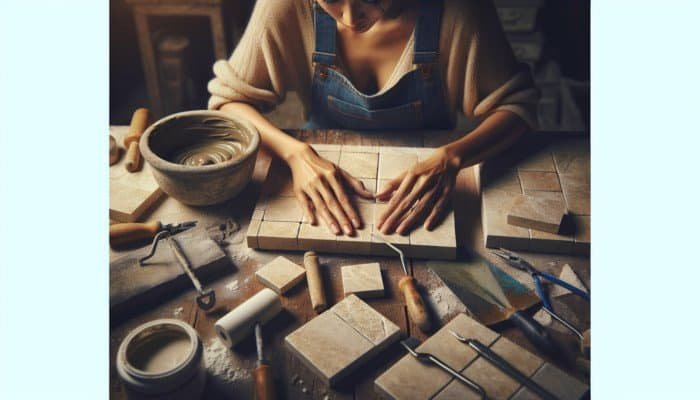


22 June 2025 by
sitemanager
Summary of “Expert Advice on Restoring Travertine Tiles“:

Travertine tiles are admired for their natural beauty and strength, but like any surface, they are not entirely immune to damage. The most common issues come from daily wear and tear—heavy foot traffic, moisture, or even poor installation. Over time, these factors can lead to scratches, scuffs, or a worn-down look. Moisture, from spills or humidity, can seep into the stone and eventually cause cracks or weakening.
Improper installation can make things worse. If the tiles aren’t laid correctly, they may shift, crack, or break under pressure. The door opens for stains and water damage if the installer doesn’t seal them properly. That’s why regularly checking your travertine surfaces is a good idea, especially in busy areas of your home. Early attention can go a long way in keeping your tiles in great shape and avoiding costly repairs later.
Awareness of the signs of wear on your travertine tiles is essential for timely intervention and maintenance. Look for visual cues such as cracks, chips, and discolouration. Initially, cracks may appear small, but they can deepen and worsen over time if not addressed promptly. Chips can detract significantly from the aesthetic appeal of your flooring or walls, leading to the necessity for immediate travertine tile repair. Discolouration, often due to stains or improper cleaning methods, can indicate deeper issues requiring urgent attention to prevent further degradation.
In addition to visual inspection, it’s equally important to assess the physical condition of the tiles. Uneven surfaces can clearly indicate underlying damage, while loose tiles may signal that the adhesive has failed or that water damage is present. Regular maintenance inspections can help you identify these signs early, preventing more extensive damage that would require professional intervention. By remaining vigilant about the condition of your tiles, you can ensure they stay beautiful and functional for many years to come.
After recognising signs of wear, the next critical step is to comprehensively evaluate the extent of the damage to your travertine tiles. Begin by examining the size and location of any cracks or chips. Minor surface-level damage may only require a straightforward repair, while extensive cracks that compromise the structural integrity of the tile might necessitate complete replacement. Using a magnifying glass to inspect the cracks closely can provide valuable insight into whether they are merely cosmetic or indicative of deeper structural issues.
Furthermore, consider the overall condition of the surrounding tiles as well. If neighbouring tiles are also damaged, it could suggest a more significant problem, such as moisture infiltration or improper installation practices. Take note of any discolouration patterns; spreading stains can indicate ongoing issues that need addressing. By systematically evaluating the damage, you can determine the most effective repair approach, helping avoid unnecessary expenses. This thorough assessment is vital for preserving the longevity and beauty of your travertine tiles, ensuring they remain a stunning feature in your home.

Gathering all the necessary tools and materials is imperative for a successful outcome before you embark on your travertine tile repair project. Essential items typically include a chisel, a rubber mallet, grout, adhesive, sealant, and a polishing compound. These tools will facilitate various repair techniques, from filling chips and cracks to effectively re-grouting and sealing the tiles.
A utility knife may also prove invaluable for removing old grout. At the same time, a sponge and a bucket of clean water are essential for cleaning the tiles both before and after repairs. Consider renting a tile cutter for a more precise fit if dealing with extensive damage. Having all tools and materials on hand streamlines the entire process and ensures that you won’t need to pause your repairs to search for missing items. By planning, you can set yourself up for a successful and efficient repair job that restores your travertine tiles to their best condition.
Safety should always be your top priority when undertaking travertine tile repair. Wear appropriate personal protective equipment, such as gloves and safety goggles, to shield yourself from sharp tools and debris that may cause injury. If you’re using chemicals, such as adhesives or sealants, ensure that you’re working in a well-ventilated area to avoid inhaling harmful fumes that could pose health risks.
Keep your workspace organised to prevent accidents; clear away any clutter and ensure that your tools are safely stored when not in use. If you’re handling heavy tiles or equipment, consider asking for assistance from a friend or family member to avoid strain or injury. By adhering to these essential safety protocols, you can focus on the task without unnecessary risks, enabling a smoother and more effective repair process that yields positive results.

Preparing the area surrounding your damaged travertine tiles is crucial for a successful repair. Start by removing any furniture and clearing the space to provide ample room for your repair activities. Next, clean the tiles thoroughly to eliminate dust, dirt, and previous adhesives or grout remnants. This meticulous cleaning ensures a solid bond when applying new materials, leading to better results.
If possible, protect adjacent surfaces with painter’s tape to avoid unintended damage during the repair process. It’s vital to ensure the area is dry before you begin any repairs, as moisture can severely compromise the effectiveness of adhesives and sealants. By meticulously preparing the repair area, you set the stage for a flawless repair that enhances the beauty and extends the longevity of your travertine tiles.
Filling cracks and chips in your travertine tiles doesn’t have to be an overwhelming task. Clean the damaged area with a damp cloth to remove debris or dust. Once the area is dry, use a chisel to gently widen the crack or chip, facilitating better adhesion of the filler material. Select a high-quality epoxy or stone repair compound that closely matches the colour of your travertine tiles for a seamless and aesthetically pleasing finish.
Apply the filler using a putty knife, pushing it firmly into the damaged area to establish a solid bond. Smooth the surface to blend seamlessly with the surrounding tiles, creating a uniform appearance. Once the filler has cured according to the manufacturer’s instructions, use fine-grit sandpaper to gently polish the area, ensuring it is flush with the rest of the tile surface. This DIY technique not only restores the appearance of your tiles but also provides essential protection against further damage, ensuring their longevity.
Re-grouting is fundamental to maintaining your travertine tiles, particularly if the grout lines have become discoloured, cracked, or otherwise damaged. Start by removing the old grout with a utility knife or a specialised grout removal tool. It is crucial to clean the grout lines thoroughly, ensuring there’s no debris left behind, as this can adversely affect the adherence of the new grout.
Mix your new grout according to the manufacturer’s instructions, and utilise a grout float to apply it evenly across the lines. Ensure the grout is packed firmly into the joints to guarantee durability and longevity. Once used, carefully remove any excess grout with a damp sponge before it hardens, to ensure a neat finish. Allow the grout to cure fully before applying a sealant to protect against stains and moisture infiltration. By re-grouting your travertine tiles, you enhance their aesthetic appeal and significantly prolong their lifespan, making it a worthwhile investment.
To achieve a professional finish, polishing and sealing your repaired travertine tiles is essential. Begin by cleaning the tiles thoroughly to remove any dust, dirt, or residue left over from the repair process. Apply a suitable polishing compound with a soft cloth or buffer, following the manufacturer’s guidelines meticulously. This will enhance the natural shine of your tiles and restore their inherent beauty, making them look as good as new.
After polishing, it’s crucial to seal the tiles to protect them from stains and moisture. Choose a high-quality stone sealant designed explicitly for travertine. Apply the sealant evenly across the tiles, ensuring comprehensive coverage. Allow the adhesive to dry thoroughly before walking on or placing furniture back onto the surface. Regular polishing and sealing not only maintain the aesthetic appeal of your travertine tiles but also significantly extend their life, making it a prudent investment for homeowners who value the beauty of their interiors.
While many travertine tile repair tasks can be effectively handled as DIY projects, certain situations warrant the expertise of a professional. If you encounter extensive damage, such as large cracks, significant discolouration, or complete tile detachment, it may be prudent to consult a qualified professional. Complex patterns or layouts may also require specialised tools and skills only experienced technicians possess to address effectively.
In addition, if your tiles have begun to lift, shift, or exhibit signs of structural instability, this could indicate deeper structural issues that necessitate a comprehensive assessment. Professionals can provide tailored solutions that are effective and long-lasting, ensuring that your investment in travertine tiles is well protected. Knowing when to seek professional assistance can save you time and money, ultimately leading to superior outcomes that enhance the beauty and functionality of your home.
Finding a trustworthy travertine tile repair service ensures quality artistry and satisfactory results. Start by seeking recommendations from friends or family who have had similar work done, as personal referrals can often lead to reliable service providers. Additionally, online reviews and ratings can provide valuable insights into the reliability and quality of local services, helping you narrow down your options.
Once you’ve identified potential candidates, it’s wise to request quotes and inquire about their experience with travertine tile repairs. A reputable provider will be transparent about their methods, materials, and processes. Don’t hesitate to ask about warranties or guarantees on their work, as this can offer peace of mind and quality assurance. By thoroughly vetting potential repair services, you can confidently select a reliable professional capable of restoring your travertine tiles to their former glory and ensuring their longevity.
When hiring a professional for travertine tile repair, it’s crucial to know what to anticipate throughout the process. A reputable service provider will begin with a comprehensive damage assessment, discussing potential solutions tailored to your needs and preferences. They should provide a detailed estimate that outlines the scope of work, materials needed, and estimated timeframes, giving you a clear understanding of the process ahead.
During the repair process, professionals will utilise high-quality materials and techniques designed to rejuvenate your tiles effectively and restore their original beauty. Once the repairs are complete, they should offer valuable advice on maintenance and care to prevent future issues from arising. By understanding the process and what to expect, you can ensure you receive high-quality service that meets and exceeds your expectations, resulting in beautifully restored travertine tiles.
Professional travertine tile repair costs can vary significantly based on many factors. The extent of the damage is perhaps the most influential determinant; minor repairs, such as small chips, will naturally be less expensive to address than extensive restoration work involving large cracks or severe discolouration. Geographic location can also play a significant role, as labour costs can differ widely across various regions in the UK.
Additionally, the type of materials required for the repair can impact overall costs. High-quality adhesives, grout, and sealants may come with a premium price tag but can ensure better results and longevity for your tiles. It is wise to obtain multiple quotes from different service providers to compare pricing and the services offered. Understanding these factors will help you budget effectively for travertine tile repairs, ensuring that your investment results in beautiful, durable flooring or wall surfaces.
After investing in professional travertine tile repair, maintaining your tiles is essential for ensuring their longevity and aesthetic appeal. Regular cleaning using pH-neutral cleaners specifically designed for natural stone is crucial to avoid damaging the surface and preserving its natural beauty. Establishing a routine cleaning schedule will help keep the tiles free from dirt, grime, and spills that could lead to unsightly staining and deterioration over time.
Additionally, consider resealing your tiles periodically, as your repair technician recommends. This preventive measure will provide an extra layer of protection against moisture and stains, enhancing the longevity of your tiles and preserving their visual appeal. By adhering to these maintenance practices, you safeguard your investment and continue to enjoy the beauty of your travertine tiles for many years, ensuring they remain a stunning feature in your home.
Consistent cleaning is essential to keeping your repaired travertine tiles looking their best. Begin by sweeping or vacuuming to remove loose debris and dust that can scratch the surface. Following this, use a damp mop with a pH-neutral cleaner designed specifically for natural stone to clean the tiles effectively. It is important to avoid harsh chemicals, as these can strip the tile’s natural finish and lead to premature damage and deterioration.
For stubborn stains, consider creating a paste from baking soda and water. Apply this paste to the affected area, allowing it to sit for a few minutes before gently scrubbing with a soft cloth. This method is effective for removing many common stains without harming the stone. By maintaining a regular cleaning routine, you can preserve the appearance and integrity of your travertine tiles for the long haul, ensuring they remain a beautiful feature in your home.
Preventing future damage to your travertine tiles involves a combination of mindful practices and protective measures. Using mats at entry points can help catch dirt and debris before it reaches your tiles, significantly reducing wear and tear. Regularly sealing your tiles is another proactive step, providing an effective barrier against stains and moisture infiltration that can lead to damage over time.
Exercise caution with the types of cleaners you use. Opting for products specifically designed for natural stone will help maintain the surface integrity and prolong the life of your tiles. If you notice any signs of wear or damage, it is essential to address them immediately to prevent further deterioration. By adopting these preventive measures, you can significantly extend the life of your travertine tiles and maintain their stunning appearance, ensuring they continue to enhance your living space for years to come.
Long-term care of your repaired travertine tiles requires a commitment to routine maintenance practices. This includes regular cleaning, sealing, and conducting inspections to identify potential issues before they escalate into significant problems. It is advisable to re-evaluate the condition of your tiles every six months, particularly in high-traffic areas where wear and tear are more pronounced.
When it comes to deep cleaning, consider hiring professional services every few years to ensure your tiles receive the thorough care they deserve. Professionals can provide specialised treatments that enhance the stone’s natural beauty and address any underlying issues that may not be apparent to the untrained eye. By prioritising long-term care, you invest in your travertine tiles’ durability and aesthetic appeal, ensuring they remain a beautiful and functional element of your home.
Promptly dealing with stains and spills on your travertine tiles is crucial for maintaining their pristine appearance and preventing lasting damage. For liquid spills, blot the area immediately with a clean, dry cloth to absorb as much liquid as possible without rubbing, as this can spread the stain further and exacerbate the problem.
Consider applying a paste made from baking soda and water for tougher stains, such as oil or food stains. Allow it to sit for several hours before gently scrubbing with a soft cloth to lift the stain. Always rinse the area thoroughly with clean water to remove any residue from the paste. Addressing stains and spills quickly and effectively will help keep your travertine tiles looking fresh, inviting, and well-maintained for years to come.
While regular care is essential, there are times when enlisting professional maintenance services for your travertine tiles can be highly beneficial. These experts possess the tools and expertise necessary to perform deep cleaning, sealing, and repairs that may exceed the scope of standard DIY methods. They can also provide tailored advice on maintaining your type of travertine, ensuring optimal care and preservation of your investment.
Consider scheduling professional maintenance every few years, especially if your tiles experience heavy foot traffic or are exposed to harsh environmental conditions. By investing in professional services, you can significantly extend the life of your travertine tiles, keeping them looking spectacular and ensuring they continue to enhance the beauty of your home for many years to come.
Several factors can significantly influence the cost of travertine tile repair. The extent of the damage is perhaps the most significant; minor chips and superficial wear will require less time and materials compared to extensive cracks, structural damage, or severe discolouration issues. Geographic location also plays a pivotal role, as labour rates can vary widely across different regions in the UK, impacting the overall cost of repairs.
Furthermore, the repair materials, including adhesives, grout, and sealants, will also affect costs. For instance, high-quality sealants explicitly designed for natural stone may be more expensive but offer superior protection and longevity. Additionally, the type of repair service you select—whether opting for a professional or taking a DIY approach—will further influence the overall price. Understanding these factors can help you budget effectively for necessary repairs, ensuring your travertine tiles remain a stunning home feature for years.
Common signs include visible cracks, chips, discolouration, and uneven surfaces. If you notice any of these issues, it’s advisable to assess the damage and consider necessary repairs to preserve the integrity of your tiles.
Yes, many minor repairs, such as filling chips and re-grouting, can be undertaken as DIY projects. However, extensive damage may require professional assistance to ensure a proper fix that maintains the beauty and functionality of your tiles.
Sealing travertine tiles every 1-3 years is generally recommended, depending on foot traffic and exposure to moisture. Regular sealing helps protect against stains and damage, ensuring the longevity of your tiles.
Use a pH-neutral cleaner specifically designed for natural stone. Avoid acidic or abrasive cleaners, as they can damage the surface and lead to deterioration over time.
Costs vary widely based on the extent of the damage, geographic location, and materials used. It’s best to obtain quotes from multiple professionals to ensure accurate pricing for the services required.
If tiles are lifting, it may indicate adhesive failure or moisture issues. Consult a professional to assess the situation and recommend the best action to rectify the problem promptly.
Prevent future damage by using mats at entry points, sealing regularly, and cleaning spills immediately to avoid staining. Additionally, avoid harsh chemicals that can harm the stone’s surface and integrity.
While regular DIY maintenance is essential, professional maintenance every few years ensures deep cleaning and thorough inspections, prolonging the life and beauty of your travertine tiles.
Yes, if tiles are extensively damaged, replacement may be necessary. A professional can help determine if replacement or repair is the best option to restore your flooring or surfaces.
A paste made from baking soda and water can be effective for stains. Apply it to the stain, allow it to sit, and gently scrub before rinsing thoroughly with clean water to remove any residue.